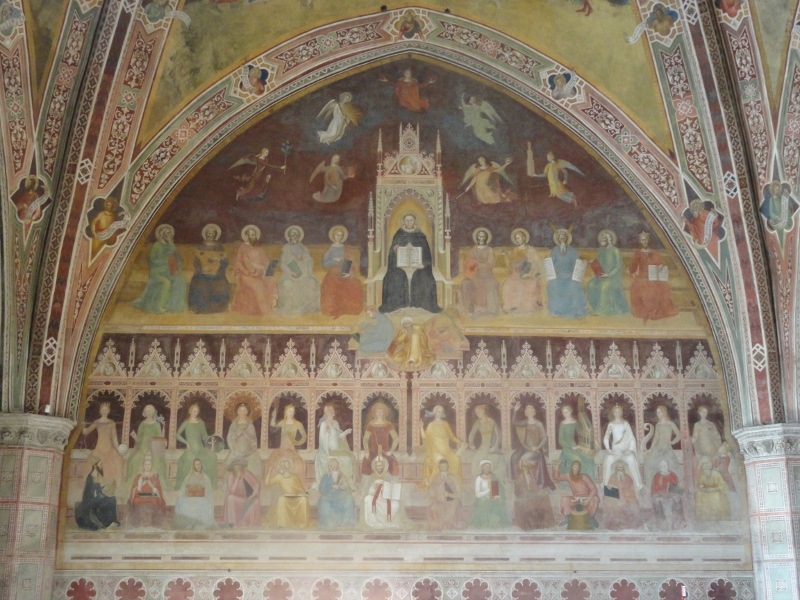The Triumph of Saint Thomas Aquinas and the Allegory of Christian Learning
Tim Laurio (son of AO Advisory member Leslie Noelani) visited Florence, Italy during the Fall 2011 semester he spent at Oxford. He made a point to see the fresco in the Spanish Chapel that Charlotte Mason wrote about, and he brought back lots of pictures. You can click the thumbnails to see larger images.
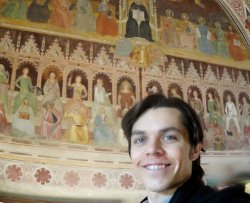

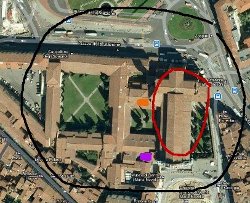
L: Tim in front of the fresco, and the front of the Basilica.
Middle: Front of the Basilica from the street.
R: Looking at a google map, the black circle is the Santa Maria Novella complex (I'm not sure how much is included in the complex; it might include the entire triangular area; Wikipedia has an entry about it here). The red circle shows the cross-shaped structure which is the Santa Maria Novella Basilica. The orange dot shows where the Spanish Chapel is. The purplish dot shows the area where you have to enter to go through the grassy courtyard to get to the Spanish Chapel. The complex has about six chapels.
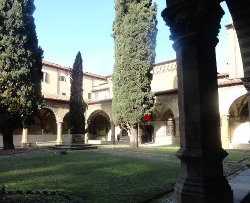


L: The red dot shows the door into the Spanish Chapel if you're looking at it from across the courtyard.
Middle: the door into the Spanish Chapel.
R: What you see as you walk through the door and enter the chapel.

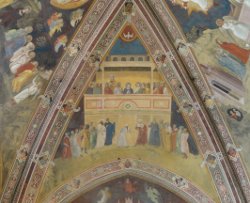

L: Fresco from the side
Middle: Arch at the top
R: Full wall
Note: Clicking the large image below will pull up a huge (over 5MB) image.
The central figure is St. Thomas Aquinas holding The Book of Wisdom with the words, "Optavi, et datus est mihi sensus: et invocavi, et venit in me Spriritus sapientiae, et preposui illam regnis et sedibus." (And so I prayed, and understanding was given me; I entreated, and the spirit of Wisdom came to me. I esteemed her more than scepters and thrones; compared with her, I held riches as nothing.) (Wisdom 7:7, 8) The figures in the fresco all relate to Aquinas's book Summa Theologia.
Flying over the throne are the Seven Virtues. The four cardinal virtues are below, and the three theological virtues hover highest, over everything else.
Temperance holds an upright branch of peace. (detail) (detail)
Prudence carries a book, since education teaches right from wrong. (detail) (detail)
Faith holds a firey light-bearing shield of faith. (detail) (detail)
Charity is highest of all, and holds her arms open. (detail) (detail)
Hope holds an olive branch. (detail) (detail)
Justice (one of the four cardinal virtues) holds the scepter (it looks like a wand) and crown denoting power to judge. (detail) (detail)
Fortitude (one of the four cardinal virtues) wears armor and carries a long sword and strong tower to resist temptation. (detail) (detail)
Sitting in a row with St. Thomas are ten Biblical figures. from L-R:
Job holding his book (detail) (detail)
David with his harp (detail) (detail)
St. Paul, writing a letter (detail) (detail)
Mark holding his gospel (detail) (detail)
Matthew holding his gospel (detail)
St. Thomas Aquinas sits in the middle on a throne. (detail) (detail)
John holding his gospel (detail) (detail)
Luke holding his gospel (detail) (detail)
Moses holding two sheets of The Law (detail) (detail)
Isaiah holding his prophecies (detail) (detail)
Solomon with his kingly crown, holding open the Book of Wisdom, which he wrote. (detail) (detail)
Under St. Thomas's feet (illustrating their unworthiness) are Nestor, Arius and Averroes who were considered heretics. (detail)
Under Thomas are The Seven Sacred Sciences (on the left) and the Seven Disciplines of the Liberal Arts, depicting both the Quadrivium and the Trivium.
The Seven Sacred Sciences are on the image's left:
The allegorical figure of Civil Law holds a sword in her right hand to enforce the Law. At her feet sits Justinian, whose code became the law of the Roman Empire. (detail)
The allegorical figure of Canonical Law holds a model of a church on her left knee. At her feet sits Clement V, a pope. (detail)
The allegorical figure of Philosophy holds a glass sphere in which Christ is teaching. At her feet sits Aristotle. (detail)
The allegorical figure of Holy Scripture. At her feets sits Jerome, wearing a wide-brimmed cardinal's hat and stroking his chin. (detail)
The allegorical figure of Theology. At her feet sits John of Damascus (detail).
The allegorical figure of Contemplation. At her feet sits Dionysius the Areopagite. (detail)
The allegorical figure of Preaching holds a bow and represents Polemic Theology, disputing questions about theology. At her feet sits St. Augustine, who wrote treatises against heresies. (detail)
On the right of the image are The Seven Liberal Arts, which include the Quadrivium and the Trivium:
Quadrivium:
The allegorical figure of Arithmetic holds a tablet (probably an iPad with a calculator app). At her feet sits Pythagoras. (detail)
The allegorical figure of Geometry with a T-square under her arm. At her feet sits Euclid. (detail)
The allegorical figure of Astronomy. At her feet sits Ptolemy, looking up to the heavens. (detail)
The allegorical figure of Music, holding a portative organ. At her feet sits Tubal Cain, with his head tilted as he listens to the pitch of his hammer hitting the anvil.
Trivium: (detail) (detail)
The allegorical figure of Dialectics in a white robe. At her feet sits Pietro Ispana (the identity of this figure is uncertain.)
The allegorical figure of Rhetoric with a paper list. At her feet sits Cicero. (detail)
The allegorical figure of Grammar, teaching a young boy. At her feet sits Priscian. (detail)
Names of persons in the images are taken from the informational plaque at the Chapel. Some sources and studies give different names. If you'd like to read more in depth about this, there's a 123 page Master's Thesis by Dale Hoover, 1991. It's available as a Pdf.
Typically in art -- "Grammar appears with book and rod, Rhetoric with tablet and stilus, Dialectic with a dog's head in her hand, probably in contrast to the wolf of heresy -- cf. the play on words Domini canes, Dominicani -- Arithmetic with a knotted rope, Geometry with a pair of compasses and a rule, Astronomy with bushel and stars, and Music with cithern and organistrum."





